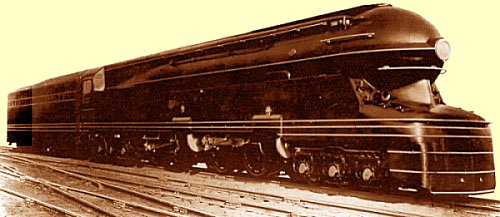Raymond Loewy
Today, finally, a design style for modern America. The University of Houston's College of Engineering presents this series about the machines that make our civilization run, and the people whose ingenuity created them.
The late Victorian era was rich in many things -- prose literature, manufacturing, science. But it also had its pockets of poverty. It produced little poetry that's lasted. And Victorian design, in particular, was heavy, ornate, and claustrophobic.
All the while, the Arts and Crafts Movement was rising in reaction to all this. By the turn of the twentieth century it'd spawned the new design school of Art Noveau, with its back-to-nature themes -- its graceful organic whirls and tendrils.
Then designers pared away the ornate trim. Art Deco replaced vines with elegant, if inorganic, straight lines. Finally, when cars, trains, and airplanes began moving fast enough to incur air resistance, streamlining found its way into popular design. The vertical linearity of Art Deco fused with horizontal streamlining, and we finally had a design style to truly embody the word modern.
One person almost single-handedly created this fusion. He was design consultant Raymond Loewy, born in France in 1893. When WW-I interrupted Loewy's design studies, he joined the artillery. He won the Croix de Guerre in combat, but he had more to say about how he had redesigned his own uniform. After the war he joined his brother, a doctor, who was called to New York to work with poison-gas victims.
Loewy was stunned by New York. The immensity, intensity, and lack of any design order offered a clean slate for him to write upon. At first he did freelance product design for Wanamaker's Store and Condé Nast. Then he was given the task of redesigning a mimeograph machine. When he was done, something that looked like a piece of industrial machinery had become Art Deco office furniture.
From that beginning, Loewy went on to create the design style of modern America. Everyone used him. He gave us the vertical lines of refrigerators we use today. His streamlined diesel locomotive design swept the American imagination. He designed the 1934 Hupmobile -- the streamlined precursor of the Chrysler Airflow.
He began giving streamline motifs to everything from clothing to pencil sharpeners. He helped to shape the modern luxury cruise ship as well as the city bus. We even find lingering elements of Loewy's streamlined design in today's farm tractors.
Look at any of the many lists of Loewy designs, and you'll realize that, without him, we wouldn't be using the word postmodern. By 1960, he'd defined modern America with such clarity and finality that we had to go looking for something different.
Indeed, we've floundered for a half-century trying to find something strong enough to follow that wild design impetus. Late in life Loewy wrote that he'd come here sixty years before and "immersed myself in the American Vortex." Wonderful line. But then we wonder: just how much vortex would there have been without Loewy there, swirling the waters.
I'm John Lienhard, at the University of Houston, where we're interested in the way inventive minds work.
(Theme music)
P. Jodard, Raymond Loewy. London: Trefoil Publications, Ltd., 1992.
R. Loewy, Never Leave Well Enough Alone. New York: Simon and Schus-ter, 1950, 1951.
Raymond Loewy, un pionnier du design américain. Paris: Centre George Pompidou, 1990.
Raymond Loewy: Pioneer of American Industrial Design. (ed. Angela Schönberger) Munich: Prestel-Verlag, 1990.
I am grateful to Margaret Culbertson, UH Art and Architecture Library, for her help and for the original suggestion by a listener whose email and whose name I have since lost.
After this program first aired, I heard from several listeners who were dismayed that I did not mention Loewy's most famous (and even beloved) designs, the 1950's Studebakers, with their futuristic streamlined headlamps.

A 1938 Loewy locomotive design